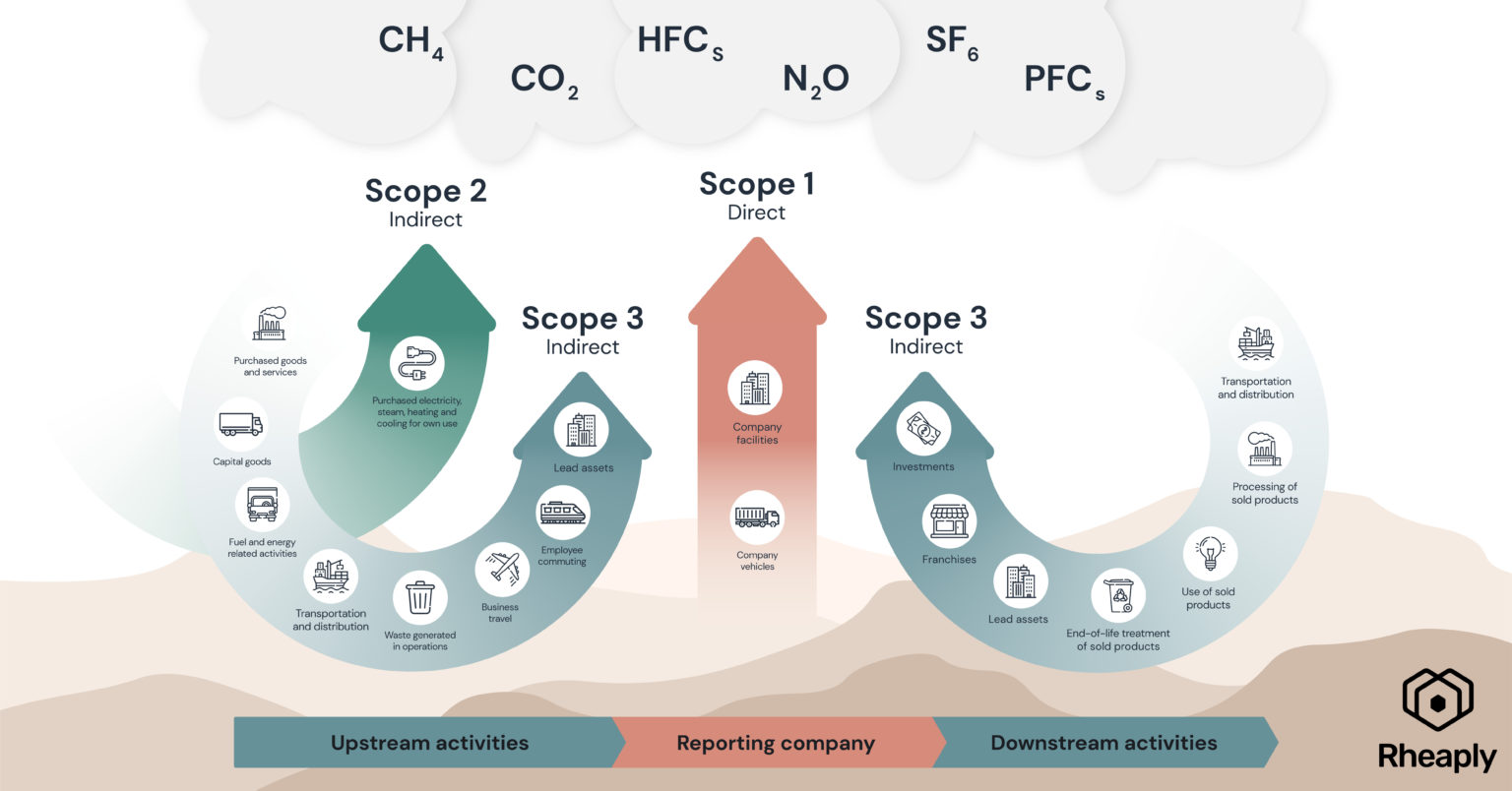Corporate Carbon Reporting
Rheaply puts reuse on the table for every organization.
Corporate carbon reporting
Corporate carbon reporting is a crucial aspect of modern business practice in which organizations monitor, track, and disclose their greenhouse gas (GHG) emissions. With climate change posing a significant threat to the environment and global economy, this type of reporting has emerged as an essential tool to drive sustainable practices and promote a circular economy.
The significance of corporate carbon reporting in business lies in its ability to provide transparency and accountability to both internal and external stakeholders. By measuring and disclosing their carbon emissions, companies can identify areas of improvement and set targets to reduce their environmental impact. This information can also serve as a valuable resource for investors and customers, who are increasingly interested in supporting climate-conscious businesses.
One of the primary benefits of carbon reporting is that it encourages the adoption of sustainable practices. Companies are motivated to invest in energy-efficient technologies, switch to renewable energy sources, and implement waste reduction strategies to lower their emissions. Additionally, businesses can use the data derived from carbon reporting to improve their supply chain management.
A circular economy, which emphasizes the need to minimize waste and maximize the value of resources, is another key concept linked to corporate carbon reporting. Circular business models the lifespan of products, reduce resource consumption, and minimize waste generation. To promote a circular economy, businesses should prioritize reusing and recycling.
Likewise, product carbon footprint is a vital metric in corporate carbon reporting that quantifies the total GHG emissions associated with a product throughout its lifecycle, from raw material extraction to end-of-life disposal. With this information, businesses can identify the most significant sources of emissions in their operations. They can also make more informed decisions on how to reduce their environmental impact.
This approach not only supports the circular economy but also enhances the overall sustainability of business operations. Organizations that leverage the right tools and strategies can do their part to lower carbon emissions and build a more sustainable future.
GHG Emissions
GHG emissions are typically classified into three scopes: scope 1, scope 2, and scope 3. These scopes help businesses to accurately measure and report their GHG emissions and identify opportunities to reduce their environmental impact.
Scope 1 emissions refer to direct GHG emissions resulting from sources owned or controlled by a company. These emissions primarily occur during the combustion of fossil fuels for energy generation, production processes, and transportation using company-owned vehicles. An example of a scope 1 emission is the carbon dioxide released by a manufacturing facility when it burns natural gas to power its operations.
Scope 2 emissions are indirect GHG emissions associated with the consumption of purchased electricity, heat, steam, or cooling. These emissions are generated during the production of energy by utilities or other third-party providers and are consumed by a company’s operations. A company looking to reduce its scope 1 and 2 emissions might invest in energy-efficient equipment, switch to renewable energy sources, or implement process improvements to minimize emissions.
Scope 3 emissions are all other indirect emissions that occur along a company’s value chain, including both upstream and downstream activities. They can be divided into several categories, with some common scope 3 emissions categories including emissions from purchased goods and services. Scope 3 emissions are often the most significant and complex component of a company’s carbon footprint, as they encompass various aspects of the supply chain.
To better illustrate scope 3 emissions examples, consider a clothing retailer. Upstream emissions in this case could include the GHG emissions generated during the production of raw materials, such as cotton farming, or the emissions resulting from the manufacturing of textiles and garments. Downstream emissions might involve the transportation of finished products to retail outlets and the disposal or recycling of garments at the end of their lifecycle.

GHG Protocol
The GHG Protocol, developed by the World Resources Institute (WRI) and the World Business Council for Sustainable Development (WBCSD), is a widely recognized and respected framework for the measurement and management of greenhouse gas emissions. It has played a pivotal role in guiding corporate carbon reporting processes.
The GHG Protocol Corporate Accounting and Reporting Standard is the cornerstone of the GHG Protocol framework. This standard helps businesses prepare a comprehensive inventory of their GHG emissions by providing clear guidance on the classification, measurement, and reporting of emissions across the three scopes. The standard also outlines the principles for accurate and complete reporting.
The GHG Protocol Scope 3 Guidance is another important component of the framework. It focuses on the quantification and reporting of indirect emissions along the value chain. This guidance assists companies in identifying, assessing, and managing scope 3 emissions. By addressing these emissions, businesses can drive sustainable practices throughout their supply chains, reduce overall environmental impact, and improve their competitive advantage.
In addition to the GHG Protocol, there are several other reporting frameworks and standards that businesses can follow to ensure robust corporate carbon reporting. Some notable examples include:
- The Greenhouse Gas Reporting Program (GHGRP): A mandatory reporting program established by the United States Environmental Protection Agency (EPA). It requires large direct emitters of GHGs, fuel and industrial gas suppliers, and facilities that inject CO2 underground to report their emissions data annually.
- The Global Reporting Initiative (GRI): An international standard for sustainability reporting, providing businesses with a comprehensive framework to disclose their economic, environmental, and social impacts.
- The Carbon Disclosure Project (CDP): This global disclosure system encourages companies and cities to measure, manage, and share their environmental information, including GHG emissions.
Corporate carbon footprint
Calculating a corporate carbon footprint involves quantifying the GHG emissions generated by a company’s operations across all scopes of emissions. This process gives businesses a better understanding of their environmental impact and allows them to identify opportunities for improvement.
To determine how to calculate the carbon footprint of a product, one must consider the emissions associated with every stage of the product’s lifecycle. GHG emission factors, which represent the quantity of emissions released per unit of activity, play a crucial role in this calculation. These factors are typically available from public databases, such as the GHG Protocol’s Emission Factors Database.
Once a corporate carbon footprint is calculated, companies can identify strategies on how to reduce their carbon footprint. Embracing circular economy principles and reuse practices can be particularly effective in achieving this goal. Some strategies include:
- Designing for durability and longevity.
- Implementing remanufacturing and refurbishment.
- Promoting recycling and upcycling.
- Encouraging collaborative consumption.
Rheaply offers numerous strategies for reducing carbon emissions. The platform provides a plethora of valuable services for corporate facility and procurement managers, including sourcing and implementing reclaimed materials and driving greater energy efficiency. Rheaply’s services are especially relevant for organizations looking to dispose of old office furniture in an environmentally-friendly manner.
Greenhouse gas reporting requirements
Legal requirements and compliance aspects associated with carbon reporting vary depending on the country, region, and specific industry sector. In the United States, the Environmental Protection Agency (EPA) plays a critical role in establishing and enforcing greenhouse gas reporting requirements. The EPA greenhouse gas regulations, established under the Clean Air Act, mandate that facilities emitting 25,000 metric tons of CO2 equivalent or more per year must adhere to the GHGRP.
To ensure compliance with emissions reporting requirements, businesses must submit their GHG emissions data by the specified deadlines, typically on an annual basis. They should also adopt the following best practices:
- Familiarize themselves with the applicable regulations and guidelines, ensuring a clear understanding of their reporting obligations and the specific methodologies required for their industry sector.
- Establish an internal emissions tracking and reporting system, which can help streamline the data collection process and facilitate accurate and timely reporting.
- Train employees responsible for emissions monitoring and reporting so that they are well-versed in the relevant guidelines and reporting procedures.
- Conduct regular internal audits to verify the accuracy and completeness of the relevant emissions data.
- Consult with external experts or engage third-party verification services, if necessary, to ensure the accuracy and compliance of the emissions reporting.
Carbon footprint report
Effective corporate carbon reporting helps businesses understand their environmental impact and communicate their sustainability efforts to stakeholders. Implementing carbon best practices can improve the accuracy, transparency, and relevance of the reporting process. Such practices include adopting a recognized standard, covering all scopes of emissions, and verifying the accuracy of reported data.
Several companies have successfully integrated circular economy and reuse strategies into their carbon reporting processes. For instance, in one notable company footprint example, Patagonia encouraged customers to repair, reuse, and recycle their products, thereby extending their lifecycle and slashing the rates of new production. In doing so, Patagonia has demonstrated its commitment to sustainability and resource conservation.
Similarly, Interface, a leading manufacturer of modular carpet tiles, adopted a circular business model focused on reducing waste and minimizing the environmental impact of its products. The company’s GHG report example showcases its “ReEntry” program, which takes back used carpet tiles, separating and recycling the materials into new products.
Viewing the carbon footprint report of any eco-minded company is a great way for organizations to learn more about carbon reduction best practices. These case studies serve as guiding examples of how to achieve long-term sustainability goals and drive greater business success.


